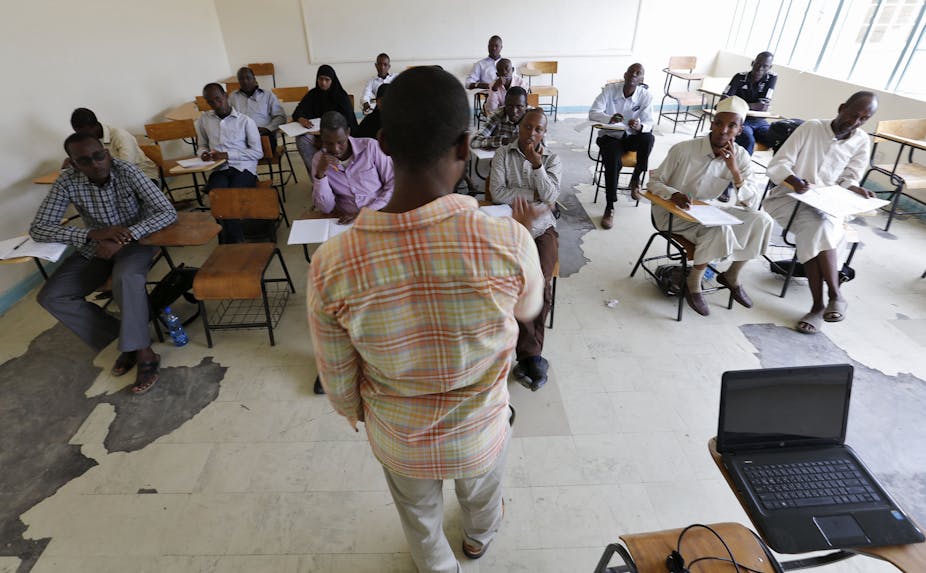If you walk down a busy street in one of Kenya’s larger cities, you’ll pass pubs, restaurants, supermarkets, brothels – and universities’ branch campuses.
These cheap, low-quality satellite campuses don’t have even the most basic facilities. They have no libraries, nor internet access. There’s usually a full-time campus director and a handful of academic staff who usually hold no more than a master’s degree. Sometimes even this degree is of questionable credibility. But these campuses raise money for the parent university and meet the country’s high demand for tertiary education.
Kenya’s Commission of University Education (CUE) has recently tried to tackle this problem by closing ten of Kisii University’s 13 branches.
The quality of Kenya universities, whether at branch level or at major, established campuses, is slipping. This process has accelerated in the past 20 years and it requires urgent work from the higher education sector and government to arrest the decline.
Changes through the decades
Kenya’s higher education system has changed significantly in the 53 years since independence. Immediately after independence, the government set up elite national universities that catered only for the fortunate few.
Then, after 1990, more Kenyans demanded access to university and the system opened up rapidly. Private universities came onto the scene, along with more public institutions.
Also in the early 1990s, the government adopted a new market-based policy of financing public universities. This ushered in an era of reduced state support for higher education.
Today, government funding for Kenya’s 33 public universities continues to decline. The average per capita expenditure per student has also fallen tremendously. This funding crunch obviously has a detrimental effect on quality, which manifests in poorly trained academic staff, inadequate libraries, overcrowded classrooms – there are sometimes as many as 400 students in a single class – and low-quality graduates.
Universities are expected to raise extra revenue through tuition fees, cost-recovery measures and by commercialising their activities. Some have taken an entrepreneurial route to raise more money: they’ve set up shopping malls, funeral homes, industrial parks, rented-out property or ventured into catering.
These are obviously unrelated to academic programs; they generate very little money and put universities’ finances and reputations at risk.
The system keeps growing
Even as funding drops, enrolment numbers soar. Kenya’s public university system has grown exponentially: there was just one at the time of independence and there are now 33. About 70% of those were established during 2012 and 2013.
Student growth has also been impressive. Just 1000 people were enrolled in 1963 and today there are 276,349 university students in Kenya, both full-time and part-time.
The combination of high enrolments and low funding has hit even established universities hard. They don’t have enough academic staff and many lecturers aren’t properly qualified. They don’t have decent teaching or learning facilities or access to innovative technology. This means that teaching often doesn’t advance beyond traditional methods.
The inferior academic climate has also seen a surge in academic fraud: plagiarism, fabricated references, students impersonating each other in exams and lecturers demanding money or sexual favours in exchange for passing grades.
In probably the most dramatic case of fraud recently, the CUE cancelled five doctoral degrees awarded by Kisii University. It emerged that the five students had only studied for six months each before receiving their doctorates.
Regulation is lacking
A weak regulatory framework has not helped the situation. The CUE, which was established in 1995, initially focused on the accreditation of private universities. Its mandate was expanded in 2013 to cover public universities – but by then, public institutions’ growth had gone unchecked for years.
The CUE lacks the organisational, technical and human capacities to monitor and enforce quality compliance. Its poor performance has led some to suggest that its CEO ought to be fired.
Professional bodies have tried to step into the gap left by the CUE’s shortcomings, intervening to close down university programs they claim are not up to industry standards. Unfortunately these bodies have no statutory powers and have been sued for their interventions.
The way forward
It will take a combination of strategies to restore quality, particularly at Kenya’s public universities. The state, regulatory authorities and the institutions themselves will need to be involved.
For starters, Kenya needs a differentiated public university system with a small number of research universities that specialise in high level research and graduate training. The University of Nairobi, Kenyatta University, Moi University, Egerton University and the Jomo Kenyatta University of Agriculture and Technology, being older and more established, all have the academic and other resources to take on this role.
Other, newer institutions established to meet demand should focus on good-quality undergraduate and master’s level instruction.
Universities must also set up faculty development programs to train academic staff about the complexities and changing nature of an academic career. This training must introduce Kenyan academics to modern teaching strategies that appeal to an evolving student demographic.
Change is needed on the money front, too. The state must change its funding model. Its current “one-size-fits-all” approach is not working, and instead programs should be financed according to how expensive they are to prepare and teach. Cheaper programmes must get less money.
Finally, regulatory oversight needs to be strengthened. The CUE requires enough money to harness its technical and human resources for effective monitoring and quality enforcement. But it can’t carry out its duties alone: professional associations and internal university quality assurance units must be involved too.

